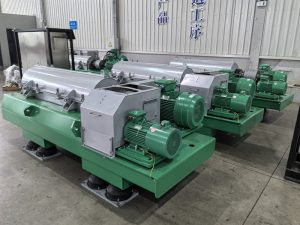IntroductioIn the pharmaceutical industry, wastewater streams often pose complex separation challenges. High levels of organics, biological materials, fine solids and chemical residues must be treated efficiently to meet regulatory and environmental standards. The GN Separation GNLW364-VFD decanter centrifuge addresses these challenges with a design focused on dewatering and reliable performance in demanding applications. According to GN’s recent news, a batch of GNLW364 units has been assembled for shipment to an overseas pharmaceutical plant wastewater treatment project. Why a High-Performance Dewatering Centrifuge Matters
For pharmaceutical wastewater, the solids content may vary, particle sizes can be fine, and the sludge may include aggressive chemicals and solvents. Using a robust decanter centrifuge helps:
-
Reduce sludge volume and footprint of sludge disposal.
-
Recover clarified water for reuse or safer discharge.
-
Increase solids dryness, improving transport and disposal cost efficiency.
-
Manage variations in feed (viscosity, density, concentration) thanks to advanced control systems.
According to GN’s site, decanter centrifuges perform well where high throughput, high dryness, and reliable operation are required.
Key Features of the GNLW364-VFD Model
Here are some of the standout features of the GNLW364-VFD (and related models) that make it well suited for pharmaceutical plant wastewater treatment:
1. Duplex stainless steel bowl (SUS 2205) construction
The bowl and screw end caps are made of duplex stainless steel (SUS 2205 or SUS 2304) produced via centrifugal casting. This provides superior corrosion resistance and mechanical strength compared to SUS 304 or SUS 316.
2. Wear protection via tungsten carbide sleeve & special screw blade design
The screw conveyor’s blade is pressed rather than drawn, improving conveying efficiency. A hard tungsten carbide sleeve protects the solids discharge port from abrasion. These design aspects support longer service life—critical when handling abrasive particulates, chemical sludges or mixed wastewater streams.
3. Optimised geometry – 8.5° beach angle, long drying zone
The T‐series dewatering decanter (which includes models like GNLW364) uses a beach angle of 8.5°, which lengthens the drying zone of the bowl and enhances dewatering performance (i.e., drier cake, clearer liquid).
4. Variable Frequency Drive (VFD) control & monitoring
The “VFD” designation highlights the use of variable frequency drives, enabling fine tuning of bowl speed, screw (differential) speed and feed pump rate. Real‐time monitoring of temperature, vibration, lubrication and other key parameters improves operational safety and consistency of performance.
5. Turnkey capability & customisation
GN states that besides supplying the dewatering decanter centrifuge, they can deliver full dewatering solutions—including material transport, classification and dewatering systems. This is especially valuable for complex wastewater treatment setups in the pharma sector.
Application in an Overseas Pharmaceutical Plant
In the referenced project, GN has assembled GNLW364‐VFD units destined for a pharmaceutical client’s wastewater treatment facility.
Here’s how the features align with typical pharma‐waste water demands:
-
Chemical & biological solids: Pharmaceutical wastewater can contain residuals from active pharmaceutical ingredients (APIs), excipients, solvents, biological media and fine solids. The high-G-force and efficient screw conveyance of the GNLW364 help manage these.
-
Abrasion & corrosion risks: With mixed chemicals and potentially abrasive particulates, the use of duplex stainless steel and wear protection ensures longevity.
-
Fluctuating feed conditions: Flow rates, solid concentrations and sludge characteristics change over time. The VFD control allows the decanter to adapt.
-
Regulatory and reuse demands: Pharmaceutical sites often target water reuse, meaning clarified effluent quality is important. The longer pool depth and extended dewatering shell improve clarity as well as dryness.
-
Minimised downtime & labour: Features like hydraulic disassembly for main bearings, gas‐spring assisted lids, and automatic lubrication support easier maintenance and operational reliability.
Benefits for the Client
By deploying the GNLW364-VFD, a pharmaceutical plant can expect:
-
Lower disposal costs: Drier solids mean less volume and lower transport/disposal costs.
-
Water recovery: Higher clarity liquid can be reused or discharged with less treatment.
-
Operational efficiency: Automation and monitoring reduce manual maintenance and risk of failure.
-
Durability: Premium materials and wear protection lower lifetime maintenance costs.
-
Tailored solution: A decanter designed and sized according to actual sludge characteristics ensures better performance than a generic machine.
Considerations for Implementation
While the equipment offers many strengths, proper implementation is essential:
-
Accurate feed characterisation: Particle size, specific gravity, viscosity, solids concentration and fouling risk must be assessed to select the right screw pitch, beach length, differential speed and pool depth.
-
Flocculation/pre‐treatment: As the GN spec states, fine particles may need flocculants to aggregate before dewatering.
-
Maintenance access and wear part planning: Even with wear protection, scheduled maintenance and spare part strategies should be in place (screw flights, tungsten carbide liners, bearings).
-
Control integration: The VFD/PLC/HMI system should be integrated with the plant’s control architecture and operators trained.
-
Waste stream variability: For pharmaceutical plants, seasonal or batch variations may occur; flexible control helps but oversight and process tracking are key.
Conclusion
For a pharmaceutical wastewater treatment application overseas, the GNLW364-VFD dewatering decanter centrifuge from GN Separation delivers a purposeful combination of durability, flexibility, and performance. Its design is aligned with the demands of the pharma sector—fine solids, variable streams, high regulatory expectations—and it supports water reuse and sludge volume reduction goals.
If you’re involved in wastewater treatment for a pharmaceutical plant or managing separation challenges, diving into the GNLW364-VFD’s specifications, conducting a site‐specific evaluation, and working with a supplier who offers full system support (as GN does) can set you up for success.